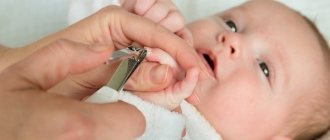The long-awaited hour of the baby's birth will not give future parents a reason to panic if they prepare responsibly for this event. A “dowry” for the baby, a comfortable bag for the maternity hospital, a list of things for mother and newborn - issues that should be resolved in advance, without haste and in a calm atmosphere. This approach will ensure that nothing important is missed. If contractions suddenly begin earlier than expected, the expectant mother will go to the maternity ward in full “combat” readiness.
When to pack your bag for the maternity hospital
There are no specific dates for when to pack your bags for the maternity hospital. According to doctors' advice, they should be ready by the end of the 36th week of pregnancy. But if there are good reasons to be alarmed about the occurrence of force majeure, it is worth buying the first things and packing bags for childbirth and the baby early.
Maternity institutions have a list of what the expectant mother needs to take with her. It is advisable to familiarize yourself with this information in advance. It is most rational to divide and arrange all things into four bags for the maternity hospital in packages, based on their purpose:
- for the maternity ward;
- kit for the postpartum period and recovery of the mother;
- baby care;
- for the discharge of mother and child.
Collected bags must be numbered and relatives must be informed when and which one needs to be delivered. One of the main sanitary and epidemiological requirements concerns the material of this accessory, because inexperienced women in labor sometimes take whatever they want. Meanwhile, a model made of transparent polyvinyl chloride would be an ideal option.
A cloth bag is prohibited in the maternity hospital due to the risk of spreading harmful microorganisms. Leather models are also undesirable.
Mandatory kits
The critical stage of childbirth and the postpartum period that follows should be as comfortable as possible for the woman and child. To collect bags for the maternity hospital, lists of things are prepared in advance. It is worth pinning a note to each package with a list of contents and those items that will need to be reported later, for example, a telephone.
To the birthplace
This is an “alarm” bag, you need to collect things for the maternity ward. The main thing is the documents, they are placed first:
- passport;
- medical policy;
- exchange card for pregnant women;
- referral or contract for childbirth;
- birth certificate;
- SNILS;
- results of the latest examinations.
A practical solution would be to purchase a PVC office folder with zippered compartments for easy document storage.
The woman in labor can also take with her money for emergency expenses, a mobile phone with a charger and headphones. A hint list of what you need to take with you to the maternity ward:
- comfortable robe;
- 2 pairs of socks;
- rubber slippers;
- cotton shirt;
- disposable razor;
- toilet seat covers;
- two packages of disposable diapers 60 x 90 cm;
- antibacterial wet wipes – 1 pack, roll of paper towels;
- three 0.5 liter bottles of drinking water - will come in handy during and after childbirth.
Many pregnant women are recommended by doctors to use anti-varicose compression stockings to reduce the risk of blood clots during childbirth. The lists may also include a couple of spare bags for packing your clothes and shoes in order to put the bags with things in storage or send them home.
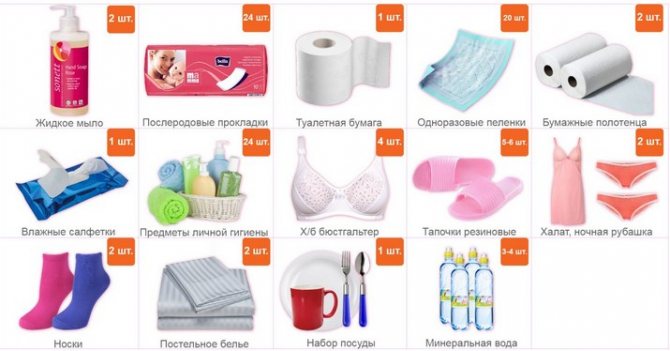
After childbirth
The stay of mother and baby in the postpartum ward is usually limited to five days. It is for this period that we collect bag “number 2”. It will be delivered by the family along with the “baggage” for the newborn.
For Mom
The list is compiled taking into account the requirements of the maternity institution. The list of what to put in your bag typically includes:
- a shirt convenient for feeding – 2 pieces;
- cotton socks – 2-3 pairs;
- bra with wide straps for nursing;
- lactation inserts for milk leakage;
- postpartum bandage corset;
- pack of 5 disposable mesh panties;
- elastic bandage;
- sanitary maxi or urological pads;
- two towels: for hands and shower;
- pen, notebook, interesting book;
- individual set of dishes, plastic bags for garbage;
- hygiene products: toothbrush, shampoo, conditioner, travel gel, antibacterial soap with dispenser;
- care items: mirror, nail scissors, cream, hair brush;
- healing cream for breasts: Bepanten, Purelan.
Before packing your bags for the maternity hospital, you should carefully review what is on the list - some things only seem necessary at first glance. And relatives can always hand over clean clothes or forgotten little things if necessary.
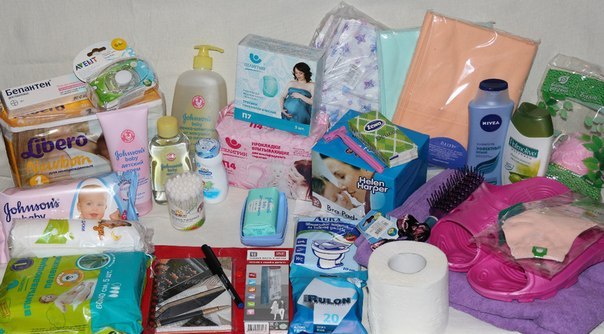
For the baby
What to take in a bag for a child to the maternity hospital is inquired in advance at the medical institution; there must be a list of permitted children's things. In the postpartum ward, the baby will need:
- breathable disposable diapers – 1 pack;
- diapers: 2 flannel, 1 knitted;
- blouses, bodysuits, vests, 2 pieces each;
- cap, cap;
- rompers, cotton “men”, 2 pieces each;
- latex pacifier;
- a set of soft small towels;
- 2 pairs of socks, anti-scratch mittens;
- children's scissors - it is better to cut off a child's long nails immediately;
- soap in a bottle with a dispenser, cream, cotton pads;
- high-quality hypoallergenic wet wipes – 2 packs;
- diaper rash cream;
- baby moisturizer, because baby's skin is prone to dryness.
Almost all maternity hospitals provide sterile diapers for newborns. But diapers and pacifiers are prohibited in some of them.
The bags collected for mother and baby contain the really necessary things. In cold weather, it's a good idea to bring a light blanket to cover your baby.

For discharge
This bag will be delivered to the maternity hospital by relatives on the eve of discharge. Collect things as in the previous case - separately for mother and child.
Take clothes for your baby according to the weather and time of year:
- diapers – 2 pieces;
- a set of thin things: a vest, rompers, a cap;
- insulated suit;
- transformable overalls or envelope, warm hat.
If you plan to return home from the maternity hospital by car, you should worry about the availability of a car seat.
When choosing an outfit for discharge, it would be correct to focus on loose-fitting clothes. The figure of the new mother has not yet recovered after childbirth and is far from ideal. You will also need:
- underwear, tights;
- outerwear, shoes - based on the time of year;
- hair dryer and hair accessories, cosmetics.
Before discharge, you must check that all issued documents are filled out correctly.
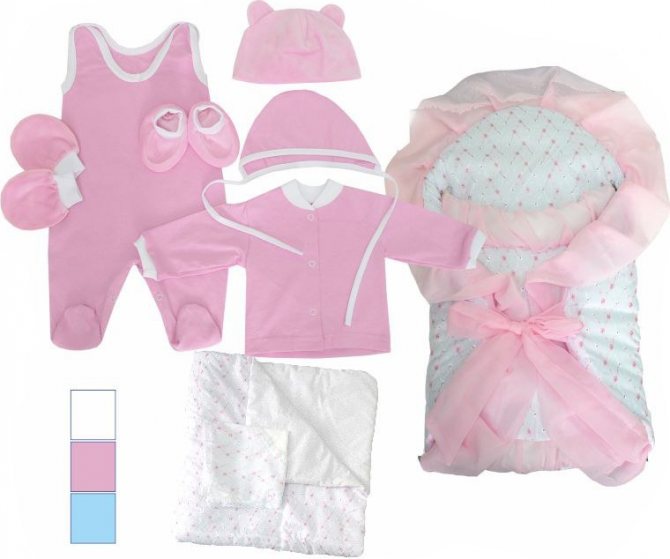
Choice of fabric and style
The fabric from which the robe is made plays an important role. Such clothes will constantly come into contact with the baby, and for this reason they should be natural. Cotton and bamboo, linen will be good in warm summer weather or in winter if the rooms are warm. In the winter cold or off-season, it is better to take a warm terry, flannel or plush robe. When choosing a robe, you should remember that the baby’s skin is very thin and delicate, so you will have to give up all kinds of embroidery or appliqués on the fabric. If childbirth is planned in cold weather, then when choosing a robe with a pile, you should run your hand over the same place several times. If there is no lint left on your hand, then this item of clothing may be suitable; if lint remains on your palm, then you need to discard this robe, even if you really liked the style and color.
When choosing a robe, you should remember that a woman in labor, and subsequently a young mother, should not sweat from the heat or freeze in a thin robe in winter. Also in winter, you should think about breast insulation to prevent complications associated with cooling the mammary glands.
Often maternity hospitals stipulate the presence of 2 gowns, one should be for going out into the corridor, toilet, shower and meeting with relatives, the second only in the ward for communicating with the child. In this case, the “guest” robe can be anything, the main thing is that the woman likes it and is comfortable for her. In cold weather, it should be a very warm material, and the cut should be such that the chest is completely covered, since it is always colder in the corridors, showers and meeting rooms than in the ward.
It is worth deciding on the length of the product. A very short robe will not cover the bottom of the shirt. It’s also not worth buying a very long one, as your legs will get tangled in the hem of your robe. Although if there are 2 types of clothes, then a long terry or flannel robe will cover your legs in cold rooms and you won’t have to wear tights or leggings to go out.
A robe for communicating with a baby should be knee-length - this is the best option. The clothes cover the shirt and do not get tangled between the legs. Going to the toilet or going to a daily gynecologist examination in such a robe is more comfortable.
Sleeve length is a very important factor. The summer version should be taken with short sleeves. When choosing a winter version of the product, it is recommended to take light measurements. To do this, you can take a doll with you to the store and, putting on the robe you like, take the doll as the child lies during feeding. The edge of the sleeve should be slightly further than the doll's head when the arm is bent, since during feeding the baby's head lies on the bend of the elbow and no thickening should interfere with the baby while sucking the breast. The sleeve should be straight, without elastic bands along its edge.
Has pockets and a hood. Pockets in a robe for the maternity hospital are not a necessary detail, but desirable. You can put directions for examination of the baby by specialists in your pocket, since your hands will be busy while moving with the child along the corridors of the hospital. At the same time, many maternity wards require feeding the baby only in a headscarf or disposable cap, which can easily fit into a pocket and will never get lost.
A hood for a robe is usually not needed, but if a woman prefers such clothing, then why not enjoy the familiar conditions in the maternity hospital.
Some people think that children love bright colors, although at first they hardly distinguish between colors. But later, after being discharged from the maternity hospital, the robe will migrate to home conditions, the child will begin to grow up and at the time of feeding will begin to look with pleasure at the bright flowers and drawings on the mother’s robe.
The smell of the material should be neutral. A high-quality robe should ideally have no odor at all.
Many artificial materials emit a not very pleasant aroma; this fact should also be taken into account when choosing a robe. The child should not inhale strange and unpleasant odors. The main thing for it should be the aroma of the mother’s body and mother’s milk.
What not to take to the maternity hospital
To prevent your maternity hospital bag from becoming a weighty and voluminous suitcase, which is highly unwelcome by the staff of the medical institution, you must strictly follow the permitted list. It is generally undesirable to take food, much less perishable provisions. Breastfeeding mothers in the maternity facility are provided with dietary nutrition, and allowed fresh food will be given to relatives after childbirth. The ban applies to carbonated drinks and coffee. The same applies to citrus fruits, chocolate products, eggs, tomatoes, smoked meats - everything that can cause allergies in a child.
Typically, laptops and tablets are not welcome in maternity hospitals, as they increase the load on electrical networks when recharging. According to fire safety rules, kettles and boilers are not allowed. Sometimes you cannot use your own clothes, dressing gowns, nightgowns. To avoid the development of bacteria, the following are prohibited:
- synthetic clothing, underwear;
- fur, woolen items;
- fabric slippers.
Breast pumping is not a mandatory position, it is only needed occasionally when the separation of mother and child is practiced. A postpartum bandage is also unlikely to be useful right away. These two things should not be taken; if necessary, relatives will always give them to you.
There is no place for any perfume in your bag; it is harmful to a newborn and can cause allergies. There is no need to take medications “just in case” and “spare” children’s things. Expectant mothers need to use common sense when packing for the hospital.
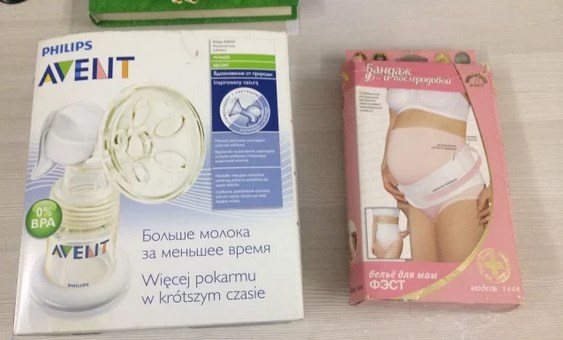
Breast pump and bandage

Foods not recommended for nursing mothers

Tablets and laptops

Perfumery
Options for maternity gowns
Currently, you can buy all the necessary clothes for a young mother in specialized stores.
Both outer and underwear will fit in size, but you should not choose a cheap robe somewhere on the market and take it several sizes larger.
This option will fly off your shoulders after childbirth and will look ridiculous, and in the maternity hospital, where you will have to constantly be with the baby, it will become impossible to pull the robe over your shoulders and waist every minute.
After a few hours of such torment, it will become irritating, and the baby will feel the mother’s condition.
There are several options for maternity hospital gowns:
- buttoned;
- on buttons;
- with smell;
- with a zipper.
All these types have their advantages and disadvantages, which are worth discussing separately. Let’s immediately make a reservation that along with the robe you should take a special nightgown for feeding the baby, which also come in several types.
Why is it better to take a robe to the maternity hospital rather than your favorite everyday clothes? There are several reasons for this:
- Constant examination by an obstetrician. It’s easier to lift up your robe than to constantly take off your leggings.
- Childbirth in a robe. At the very moment of childbirth, the woman is dressed in a robe and a shirt; everything below the waist must be removed, and it is not very comfortable to lie in the delivery room in just a short T-shirt.
- The moment of contractions. At this time, women often want to go to the toilet, and taking off and putting on pants or leggings during such a difficult time will quickly get boring and exhaust the nervous system.
- After childbirth. The woman is left to lie in the delivery room for another hour or two, and it may not be very warm there. At the time of birth, the young mother sweats, she feels hot, and after that she becomes very cold and uncomfortable. Therefore, by wrapping your robe around you can protect yourself from unnecessary health problems.
- Feeding. It is very difficult to constantly raise and lower the T-shirt, and it also falls on the newborn's face when feeding. It is much easier to unfasten the robe slightly to attach the baby to the breast.
We have figured out the need for this accessory, now it’s time to choose a robe from the presented types.
Advantages of ready-made kits
There are many specialized stores offering already assembled bags for the baby and mother in the maternity hospital. They contain ready-made kits with a sufficient number of necessary things. The composition of the bags complies with sanitary rules and requirements of the administration of maternity institutions. In the absence of time, when there is no time to look for an answer to the question of what set of things needs to be prepared, especially if it is the first birth, it is convenient to buy a ready-made option. Experienced mothers in labor recommend the “I’ll Be a Mother” maternity hospital bag: the price is affordable, the composition of the items is optimal. Of the more expensive options, the “Organic” set of the maximum configuration with newfangled products, as well as the “Comfort” bags, received good reviews. The downside of all, no matter the ready-made options, is the likelihood of the presence of unnecessary things or a lack of necessary ones, because each mother and child are still individual.
The expectant mother must decide for herself which option is more acceptable to her - a store-bought kit or a bag she assembled herself. In any case, timely and thoughtful preparations will avoid unnecessary stress.







